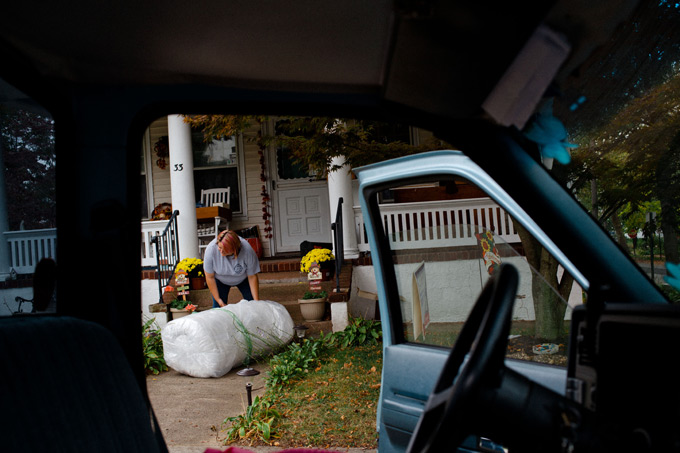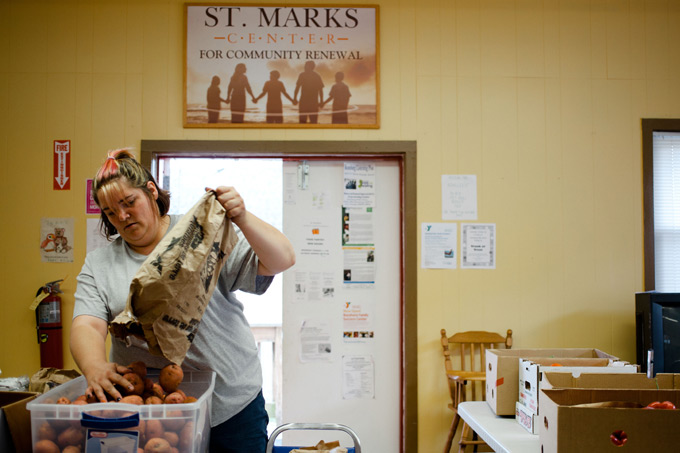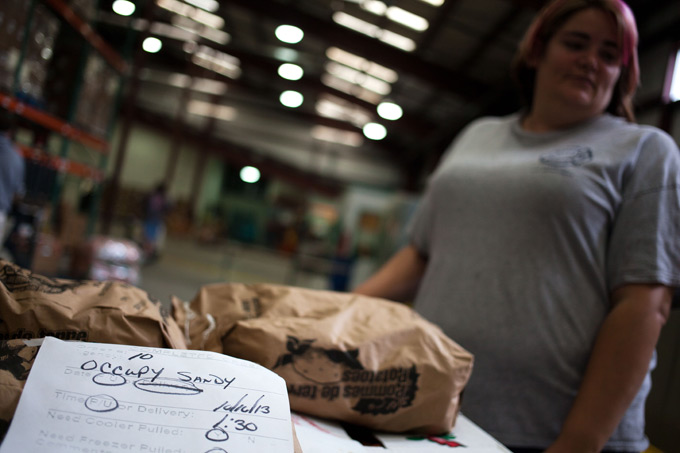
Alyssa Durnien loads bedding into her truck. Although Hurricane Sandy battered the East Coast a year ago, many in Durnien’s town of Keansburg, New Jersey are still reconstructing their homes and lives. Photo by Matt Richter, 2013.
Correction Appended
After the storm broke through the protective seawalls, the town of Keansburg, New Jersey flooded in mere minutes. On the night of October 29, as Hurricane Sandy battered the beachfront town, Alyssa Durnien was one of the residents called in by the volunteer fire department to support the first responders. For those first few days, she did the simple, but essential tasks that kept the whole operation running, like making sure that dozens of first responders were fed and coffee was in the coffee pot. By Thanksgiving, Durnien was driving around with 35 donated turkeys in the back of her Volkswagen asking local businesses, “How many can you cook?” By spring she was a member of the Keansburg Volunteer EMS and a regular volunteer at the Center for Community Renewal, a local food pantry that had grown after the storm.
Today, on the one-year anniversary of the storm, the once-thriving coastal neighborhood of Good Luck Point in Bayville, New Jersey—located 50 miles south of Keansburg is utterly abandoned, populated only by young cedars and uncut reeds. Across the region, renters’ apartments have been damaged and disfigured, and tenants are struggling to relocate or to pay hiked monthly rates. As this series of Creative Time Reports dispatches on “in-between homes” has explored, many families and neighborhoods are still far from returning to the normalcy of their pre-storm lives, a process that could take years.
For a few like Durnien, a pragmatic 36-year-old who used to work as a veterinary technician, the experience of the storm wasn’t as much a temporary dislocating experience as a permanent step toward being exactly where they wanted to be: immersed as organizers, volunteers and active neighbors in their own communities. By the spring, Durnien had helped transform a small community soup kitchen into one of New Jersey’s most dynamic long-term relief centers. The skills learned meant that even people in Oklahoma were seeking her guidance as they learned to cope with the deadly May tornado. “For the first time in my life I feel complete,” Durnien said when we first spoke with her in July at her home.
With reindeer-patterned pants and a reindeer-decorated car, she distributed holiday gifts and homemade cookies to families who had been affected by the storm. Besides the pants and the cookies, Christmas Day wasn’t really out of the ordinary for Durnien’s new life. At the time, she was one of many volunteers that supported a mobile cafe that distributed food out of a U-Haul, traveling from Union Beach to Sea Bright, providing hot meals to residents.

Durnien drives up and down the New Jersey coastline. Photo by Matt Richter, 2013.
Durnien linked up with Occupy Sandy activists, who helped her purchase a truck and gave her a crash course in community organizing. She’d never even heard of Occupy Wall Street before joining Occupy Sandy, but she quickly became one of its core organizers in New Jersey—even as she coped with her own storm-related challenges. The flooding that swept through Keansburg destroyed part of Durnien’s home, forcing her to live through months of construction work to remove the black mold that began growing in her walls.
The combination of days spent outside feeding people and nights spent sleeping in an unfinished house meant Durnien was constantly getting sick. Finally, after her 14th round of antibiotics, she began searching for a central space to continue her work. She ended up at the St. Mark’s Center for Community Renewal in Keansburg.
The center had existed for two decades before Sandy, and so had many of the town residents’ need for food assistance. From Durnien’s own upbringing, she could recognize when people were struggling financially, even when they tried to hide it. During her own childhood in Tennessee, she remembers her mother inventing tricks like putting canned cranberry sauce in the freezer to make slushies so she didn’t have to explain to her daughter why the family couldn’t afford to buy ice cream.
Durnien also knew how to recognize an opportunity. The outpouring of support and donations after Sandy provided a chance to expand the center’s services for those who had been struggling for years before the water rushed in. Durnien realized that she could help turn recovery efforts into more robust and sustainable forms of community assistance.

Since the spring, Durnien has volunteered at the St. Mark’s Center for Community Renewal, helping expand its food program and create an organic garden. Photo by Matt Richter, 2013.
She began by stocking the food pantry at the St. Mark’s Center. In March she pitched the idea of starting an organic garden. Once approved, the initiative grew quickly.
“Every day the guests ask, can I have this squash there? And I say, ‘Yeah, but you have to pick it, and you have to grab a weed while you’re out there.’”
Turning a relief center into a space where everyone worked together to meet their own needs created an immediate change. “It made the center theirs,” Durnien said. “It’s a place they’re excited to come to, rather than feeling like it’s just some place they’re going to because they have nowhere else to go.”
She spurred other initiatives, too, including organizing a scavenger hunt for neighborhood kids to find (and remove) the strangest foreign objects washed into the local creek by the storm. Among the winners: a washing machine, 45 tires and a bikini bottom.
In many ways, Sandy recovery engulfed all civic life in Keansburg—not just Durnien’s. During the Saint Patrick’s Day parade, residents threw rubber cleaning gloves into the crowd from the float. The foreclosed homes, which had stood empty and filled with mold since the depths of the economic crash, weighed on everyone’s mind. “Banks are not interested in doing mold remediation,” Durnien observed. After the first scavenger hunt, a beach cleanup shift became a requirement for public school students looking to sign up for fall sports.
But for Durnien, the work became a respite from her former life, and once she’d experienced it, she decided not to go back. She walked away from her former salary and now lives on the $250 weekly stipend she receives from Occupy Sandy NJ.

Over the last year, Durnien has coordinated the donation of tens of thousands of meals with the help of Occupy Sandy. Photo by Matt Richter, 2013.
“I used to punch in, go do my work, and leave at five in the afternoon. I work harder and a lot more now than I ever did it my life. . . . But I’m not just doing a job. I’m doing something I’m called to do.”
No matter how damaging the storm had been, for Durnien and hundreds of other resident-organizers in affected neighborhoods along the northeastern seaboard, the key was in realizing that power already existed within their own communities. And unlike the power of a FEMA volunteer or temporary voucher, this kind of self-organized power doesn’t vanish. It only needs to be harnessed and mobilized.
Photos by Matt Richter. Interview with Alyssa Durnien by Rachel Falcone and Michael Premo.
This article is the third in a series exploring “In-Between Homes”—the places and states where people across New York City and New Jersey are living in the wake of Hurricane Sandy. To add your voice to this growing storyline, please contribute your story.
Correction: November 1, 2013
An earlier version of this article misrepresented Alyssa Durnien’s testimony regarding her role as part of the “U Hungry?” truck volunteer effort. Durnien stated in her interview that “U Hungry?” was a large collaborative effort that helped inspire her continued work with food distribution, and the article has been updated to reflect that. The article also incorrectly stated that she was an EMT; she is an active member of the Keansburg Volunteer EMS.
Sandy Storyline is a storytelling project that collects and shares stories about the impact of Hurricane Sandy on our community and lives. This post is based on oral history provided by Alyssa Durnien, about her evolution to become a resident-organizer with Occupy Sandy and the Center for Community Renewal. Sandy Storyline consists of stories contributed by residents and volunteers themselves, or recorded as part of workshops or oral history interviews. It is only through your voice and contributions that we can share a full picture of the relief efforts. Please share your memories and experiences of how Hurricane Sandy impacted your life by contributing here: sandystoryline.com/participate.

